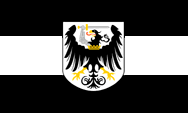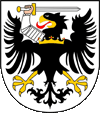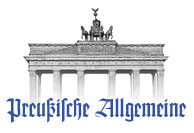Westpreußen |
|
|
|
| Übersicht – Contents: | |
Westpreußen |
|
|
|
| Übersicht – Contents: | |
Flaggen – Flags: |
|
 |
Landesfarben – colours of the country, Quelle/Source: Wikipedia (D) |
 |
Dienstflagge der Provinz – official flag of the province, (zweifelhaft – doubtful) |
|
|
|
Bedeutung/Ursprung der Flagge – Meaning/Origin of the Flag: |
|
| Ab 1875 konnten die Provinzen Preußens weitestgehend Selbstverwaltung betreiben. Es gab Provinziallandtage und eine provinziale Regierung (Provinzialausschuss). Jede Provinz hatte ihre Landesfarben, die auch als Flagge verwendet wurden, und auch ein Wappen. Ob die Provinzregierungen ihre Landesfarben-Flaggen für amtliche Zwecke (Dienstflagge) dem einem Wappen belegten ist nicht zweifelsfrei und nicht für alle Provinzen überliefert. | From 1875, the provinces of Prussia could largely operate in self-governing. There was a provincial parliament and a provincial government (Provincial Committee). Each province had its own colors (Landesfarben), which were also used as flag, and they had also their own coat of arms. If the provincial governments put for official purposes (official flag) their coats of arms on a flag with the provincial colors is not handed down beyond doubt and not for all provinces. |
| Die Flagge der Provinz Westpreußen zeigt drei waagerechte Streifen in Schwarz, Weiß und Schwarz, ist also eine Kombination aus den preußischen Farben Schwarz und Weiß. Besonders charakteristisch ist der im Wappen dargestellte Adler. Er hat außer Flügeln noch einen Schwertarm. (siehe → Wappen) | The flag
of the province Westprussia shows three stripes in black, whita and black,
and is so a combination of the prussian colours black and white. Especially characteristic is the in the coat of arms depicted eagle. He has besides wings even a sword arm. (look → Coat of arms) |
| Quelle/Source: Volker Preuß | |
Wappen – Coat of Arms: |
|
 |
bis/to 1920, Wappen der Provinz Westpreußen – Coat of arms of the Province of West Prussia, Quelle/Source nach/by: Deutsche Wappen Rolle |
|
|
|
Bedeutung/Ursprung des Wappens – Meaning/Origin of the Coat of Arms: |
|
| Die Ursprünge der preußischen Heraldik sind im Königlich-Polnischen Preußen zu suchen, als diese Gebiete (Pomerellen [das spätere Westpreußen], Kulmer Land, Marienburg und Elbing) 1466 vom Deutschen Orden an das Königreich Polen abgetreten und ein Lehen des Polnischen Königs wurden. Für dieses Land wurde ein Wappen geschaffen. Es zeigte den polnischen Adler in Schwarz auf silbernem (weißem) Untergrund mit einem Schwertarm. Die Farben wurden wahrscheinlich nicht zufällig gewählt, immerhin war das Königlich-Polnische Preußen vorher Territorium des Deutschen Ordens, dessen Farben Schwarz und Weiß waren (Schwarzes Kreuz auf weißem Grund). Im Jahre 1525 wandelt Hochmeister Albrecht den verbliebenen Ordensstaat (im Prinzip das Gebiet des späteren Ostpreußen, jedoch ohne das Bistum Ermland) in das weltliche Herzogtum Preußen um, Albrecht wird Herzog und schwört dem polnischen König den Lehenseid. Wieder wurde dafür ein Wappen geschaffen, wieder nach den gleichen Prinzipien. Es zeigte den polnischen Adler in Schwarz auf silbernem (weißem) Untergrund und er hatte ein gekröntes Brustschild mit der Initiale "S" des polnischen Königs Sigismund. Damit war das Wappen Preußens geschaffen. Später, als Preußen in Provinzen eingeteilt wurde, wurde dieses preußische Ur-Wappen zum Wappen der Provinz Ostpreußen, jedoch ohne das Brustschild mit dem "S", das schon 1557 mit dem Wegfall der polnischen Lehenshoheit obsolet geworden war. Anlässlich der Polnischen Teilungen konnte Preußen im Jahre 1772 das Königlich-Polnische Preußen wieder erweben. Dessen Wappen (Der Adler mit dem Schwertarm) wurde für die spätere Provinz Westpreußen übernommen. |
The origins of the Prussian heraldry can be found in Royal Polish Prussia
when these areas (Pomerelia [later West Prussia], Kulm Land, Marienburg and
Elbing) were ceded to the Kingdom of Poland in 1466 and became a fief of the
Polish king. A coat of arms was created for this country. It showed the
Polish eagle in black on a silver (white) background with a sword arm.
The colors were probably not chosen at random, after all, the Royal Polish
Prussia was previously a territory of the Teutonic Order, the colors of the
order were black and white (black cross on a white background). In 1525, Grand Master Albrecht converted the remaining State of the Teutonic Order (in principle the area of what would later become East Prussia, but without the Diocese of Warmia) into the secular Duchy of Prussia, Albrecht became the duke and swore the oath of fief to the Polish king. Another coat of arms was created for this, again according to the same principles. It showed the Polish eagle in black on a silver (white) background and it had a crowned breastplate with the initial "S" of the Polish king Sigismund. The coat of arms of Prussia was thus created. Later, when Prussia was divided into provinces, this original Prussian coat of arms became the coat of arms of the province of East Prussia, but without the breastplate with the "S", which had already become obsolete in 1557 when the Polish feudal sovereignty ceased to exist. On the occasion of the Polish divisions, Prussia was able to gain Royal Polish Prussia in 1772. Its coat of arms (the eagle with the sword arm) was adopted for the later province of West Prussia. |
| Quelle/Source: Volker Preuß, Deutsche Wappen Rolle, www.heraldique.org | |
|
Lesen Sie hier:
Hintergründe, Geschichte und Fakten zum Thema "Der Adler in der Heraldik"; Ausführungen, Varianten und Entwicklung. |
 |
Landkarte – Map: |
|||
|
|||
| Die historische Landkarte zeigt in der Mitte die Provinz Westpreußen zwischen den Jahren 1815 und 1866. | The
historical map shows in the middle the Province of West Prussia between the
years 1815 and 1866. | ||
Zahlen und Fakten – Numbers and Facts: |
|
|
|
|
|
|
|
|
|
|
|
|
Geschichte: |
|
|
seit 1226/1309 · zum Staat des Deutschen Ordens 1466 · zu Polen 1772 · zu Preußen 1824 · Vereinigung mit Ostpreußen zur Provinz Preußen 1878 · Bildung der Provinz Westpreußen 1920 · in Folge des Versailler Diktats Auflösung und Vierteilung Westpreußens: 1. Pomerellen (zu Polen) 2. Danzig (Freie Stadt) 3. Regierungsbezirk Westpreußen (zur Provinz Ostpreußen) 4. Kreise Deutsch-Krone, Flatow und Schlochau (zur Grenzmark Posen-Westpreußen) |
|
History: |
|
|
since 1226/1309 · to the
State of the Teutonic Order (teutonic knights) 1466 · to Poland 1772 · to Prussia 1824 · unification with East Prussia to the Province of Prussia 1878 · creation of the Province of West Prussia 1920 · in result of the Versailles dictate dissolution and partition of West Prussia: 1. Pomerellen (to Poland) 2. Danzig (free town) 3. governmental district West Prussia (to the Province of East Prussia) 4. districts of Deutsch-Krone, Flatow and Schlochau (to the Border-Province of Posen - West Prussia) |
|
|
Quelle/Source:
Atlas zur Geschichte,
Wikipedia (D),
Discovery '97,
Schwarzbuch der Vertreibung
|
Ursprung des Landesnamens – Origin of the Country's Name: |
|
| Der Name des Landes geht auf das baltische Volk der Prußen (auch Pruzzen genannt) zurück, das im 13. Jahrhundert im gebiet des heutigen Ostpreußen lebte und im Auftrag des Königs von Polen durch den Deutschen Orden unterworfen und christianisiert wurde. Der Kurfürst von Brandenburg aus dem Hause Hohenzollern trug ab 1618 zusätzlich den Titel Herzog in Preußen, und nannte sich ab 1701 König in Preußen. So kam es dazu, dass ab dieser Zeit alle hohenzollernschen Territorien unter dem Namen Königreich Preußen zusammengefasst worden. | The name of the country goes back to the Baltic people of the Old Prussians (in German called Pruzzen), who lived in the 13th century in the area of today's East Prussia, and were subjugated and christianized by the Teutonic Order on behalf of the King of Poland. The Elector of Brandenburg from the House of Hohenzollern also held the title of Duke in Prussia from 1618, and from 1701 he called himself King in Prussia. As a result, from this time on, all Hohenzollern territories were combined under the name of the Kingdom of Prussia. |
| Quelle/Source: Wikipedia (D) | |
 |
Preußische Allgemeine Zeitung Die Fundgrube für Geschichtsbegeisterte. Mit sehr großem kostenlosen Archiv mit den kompletten Ausgaben dieser Zeitung mit sehr interessanten Artikeln über die preußische Geschichte. |